Design and development
The Bergmann gun used a lock system patented by Theodor Bergmann in 1901 along with the short recoil principle of operation. The locking system, in which a cam moves a lock vertically in the weapon, was not dissimilar to the Browning machine gun designs. The original design, borrowing from the 1910 pattern, was a heavy ground-based weapon fitted with a water-cooling jacket. The weapon was then lightened for both infantry and aircraft use. For aircraft usage, the bolt was lightened and the mechanism sped up from 500 rounds per minute to 800. For ground use, this weapon was adopted as the Bergmann MG 15. The receiver to the weapon was machined down and lightened, featured a butt stock fitted to the end of the weapon. It was given a pistol grip and trigger grouping instead of spade grips, the heavy cooling jacket was replaced with a thin perforated barrel shroud and a bipod was fitted halfway down the barrel.
The major development of the weapon came early in 1916 when the Bergmann MG 15 was converted into a second variation to mirror the development of the Maxim MG 08/15. The bolt was slowed back down as the original had stoppage issues when used in the ground role. The bipod was removed from the flimsy barrel shroud and relocated to just forward of the pistol grip using a swivel-mount that accepted the bipod shared between the Bergmann and Maxim guns. A carry handle and new sights were also added. When this variation was adopted, it was called the Bergmann MG 15nA, the nA standing for neuer Art ('new model'). The old pattern was then renamed the Bergmann MG 15aA for alter Art ('old model'). The MG 15nA saw much more frequent use amongst Imperial German forces than the MG 15aA.
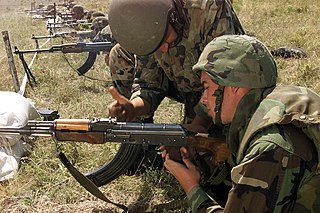
A squad automatic weapon (SAW), also known as a section automatic weapon or light support weapon (LSW), is a man-portable automatic firearm attached to infantry squads or sections as a source of rapid direct firepower. Weapons fulfilling this role can be light machine guns, or modified selective-fire rifles fitted with a heavier barrel, bipod and a belt/drum-fed design.
The MG 34 is a German recoil-operated air-cooled general-purpose machine gun, first tested in 1929, introduced in 1934, and issued to units in 1936. It introduced an entirely new concept in automatic firepower – the Einheitsmaschinengewehr – and is generally considered the world's first general-purpose machine gun (GPMG). Both the MG 34 and MG 42 were erroneously nicknamed "Spandau" by Allied troops, a carryover from the World War I nickname for the MG 08, which was produced at the Spandau Arsenal.
The MG 42 is a German recoil-operated air-cooled general-purpose machine gun used extensively by the Wehrmacht and the Waffen-SS during the second half of World War II. Entering production in 1942, it was intended to supplement and replace the earlier MG 34, which was more expensive and took much longer to produce, but both weapons were produced until the end of World War II.

The Maschinengewehr 30, or MG 30 was a German-designed machine gun that saw some service with various armed forces in the 1930s. It was also modified to become the standard German aircraft gun as the MG 15 and MG 17. It is most notable as the design pattern that led to the MG 34 and MG 42, and thus is one of the major ancestors of many of the weapons in service which would later find widespread use into the 21st century.

The Lewis gun is a First World War–era light machine gun. Designed privately in the United States though not adopted there, the design was finalised and mass-produced in the United Kingdom, and widely used by troops of the British Empire during the war. It had a distinctive barrel cooling shroud and top-mounted pan magazine. The Lewis served to the end of the Korean War, and was widely used as an aircraft machine gun during both World Wars, almost always with the cooling shroud removed, as air flow during flight offered sufficient cooling.

The FN Minimi is a Belgian 5.56mm light machine gun, also classified as a squad automatic weapon developed by Ernest Vervier for FN Herstal. Introduced in the late 1970s, it is in service in more than 75 countries. The weapon is manufactured at the FN facility in Herstal and their U.S. subsidiary FN Manufacturing LLC.
The MG 15 was a German 7.92 mm machine gun designed specifically as a hand-manipulated defensive gun for combat aircraft during the early 1930s. By 1941 it was replaced by other types and found new uses with ground troops.

The FN MAG is a Belgian 7.62 mm general-purpose machine gun, designed in the early 1950s at Fabrique Nationale (FN) by Ernest Vervier. It has been used by more than 80 countries and it has been made under licence in several countries, including Argentina, Canada, Egypt, India and the United Kingdom.
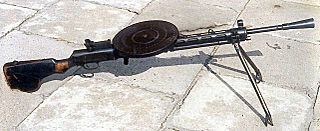
The Degtyaryov machine gun or DP-27/DP-28 is a light machine gun firing the 7.62×54mmR cartridge that was primarily used by the Soviet Union, with service trials starting in 1927, followed by general deployment in 1928.

The PK is a belt-fed general-purpose machine gun, chambered for the 7.62×54mmR rimmed cartridge.

The Maschinengewehr 08, or MG 08, was the German Army's standard machine gun in World War I and is an adaptation of Hiram S. Maxim's original 1884 Maxim gun. It was produced in a number of variants during the war. The MG 08 served during World War II as a heavy machine gun in many German infantry divisions, although by the end of the war it had mostly been relegated to second-rate fortress units.

A heavy machine gun (HMG) is significantly larger than light, medium or general-purpose machine guns. HMGs are typically too heavy to be man-portable and require mounting onto a weapons platform to be operably stable or tactically mobile, have more formidable firepower, and generally require a team of personnel for operation and maintenance.

The Vickers K machine gun, known as the Vickers Gas Operated or Gun, Machine, Vickers G.O. .303-inch in British service, was a rapid-firing machine gun developed and manufactured for use in aircraft by Vickers-Armstrongs. The high rate of fire was needed for the short period of time when the gunner would be able to fire at an attacking aircraft. The weapon was adopted for land use during World War II.
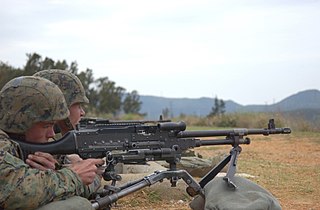
A medium machine gun (MMG), in modern terms, usually refers to a belt-fed machine gun firing a full-powered rifle cartridge, and is considered "medium" in weight. Medium machine guns are light enough to be infantry-portable, but still cumbersome enough to require a crew for optimal operational efficiency.

The HK21 is a German 7.62 mm general-purpose machine gun, developed in 1961 by small arms manufacturer Heckler & Koch and based on the G3 battle rifle. The weapon is in use with the armed forces of several Asian, African and Latin American countries. It was also license-manufactured by Fábrica de Braço de Prata in Portugal as the m/968 and in Mexico by SEDENA as the MG21. In the German military (Bundeswehr) and the federal police (Bundespolizei) it is designated "G8".
The Ameli is a 5.56mm light machine gun designed for the Spanish Army by the nationally owned and operated Centro de Estudios Técnicos de Materiales Especiales (CETME) small arms research institute.
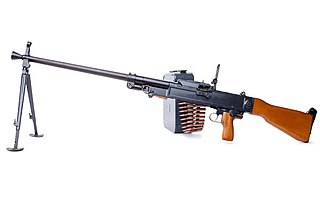
The Universal Machine Gun Model 1959 is a general-purpose machine gun developed in Czechoslovakia in the 1950s. It remains in use by the Czech Army and the Slovak Armed Forces.

The Parabellum MG 14 was a 7.92 mm caliber World War I machine gun built by Deutsche Waffen und Munitionsfabriken. It was a redesign of the Maschinengewehr 08 machine gun system intended for use on aircraft and zeppelins. Like the earlier Vickers machine gun, it used a toggle action that broke upwards rather than downwards, the opposite way to the MG 08, making for a much more compact receiver. The fusee spring was replaced with an internal spring design, the breech block was completely different and the spent cartridges dropped out the bottom of the receiver, rather than being ejected forward through a hole under the breech from the receiver. There appear to be no action or receiver parts interchangeable with the MG 08. The MG 08's belt-style ammunition feed was enclosed in a drum, the recoil casing was lightened and the cooling jacket was modified for air- instead of water-cooling. The rate of fire was 700 rounds/minute. The belt was reduced to 30 mm in width.

The 7.5 mm Maschinengewehr 1951 or Mg 51 is a general-purpose machine gun manufactured by W+F of Switzerland. The weapon was introduced into Swiss service when the Swiss Army initiated a competition for a new service machine gun to replace the MG 11 heavy machine gun and the Furrer M25 light machine gun adopted in 1911 and 1925 respectively.
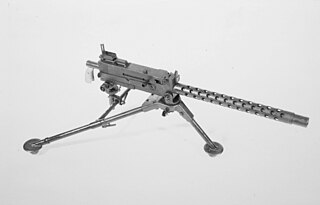
The M1919 Browning is a .30 caliber medium machine gun that was widely used during the 20th century, especially during World War II, the Korean War, and the Vietnam War. The M1919 saw service as a light infantry, coaxial, mounted, aircraft, and anti-aircraft machine gun by the U.S. and many other countries.
















